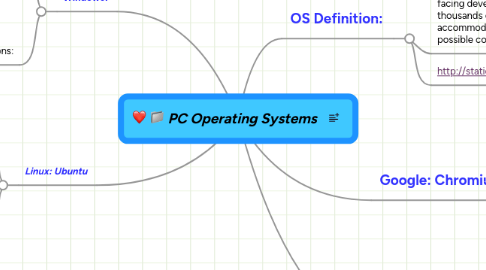
1. Windows7
1.1. Pros:
1.1.1. Most popular operating system, Everyone uses it.
1.1.2. Easy to use.
1.1.3. More applications
1.2. Cons:
1.2.1. Not free, limite usage.
1.2.2. Not stable, BSOD
1.2.3. Does not have good applications.
1.2.4. Most spywares and viruses are targeted to this platform.
2. Linux: Ubuntu
2.1. Pros:
2.1.1. Free sofware and open source.
2.1.2. Multimedia, Web Server, Music Creation.
2.1.3. Frequent Updates
2.1.4. Community Support
2.2. Cons:
2.2.1. Unstable, many crashes
2.2.2. Hardware not standard
2.2.3. Lack of high quality professional software
2.2.4. http://blog.hafees.com/windows/windows-linux-and-mac-a-comparison/
3. OS Definition:
3.1. an operating system can ensure that applications continue to run when hardware upgrades and updates occur. This is because the operating system -- not the application -- is charged with managing the hardware and the distribution of its resources. One of the challenges facing developers is keeping their operating systems flexible enough to run hardware from the thousands of vendors manufacturing computer equipment. Today's systems can accommodate thousands of different printers, disk drives and special peripherals in any possible combination.
3.2. http://static.howstuffworks.com/gif/operating-system-architecture.gif
4. Google: Chromium
4.1. Chromium OS is an open-source project that aims to build an operating system that provides a fast, simple, and more secure computing experience for people who spend most of their time on the web.
4.2. http://dev.chromium.org/chromium-os
5. Mac OS X
5.1. Pros:
5.1.1. Applications- a large number of excellent professional applications are availavle in this platfirm. , prefferred by designers and other professionals.
5.1.2. Easy installation of application
5.1.3. Targeted less by viruses and spywares
5.2. Cons:
5.2.1. It is proprietary.
5.2.2. Expensive
5.2.3. Must pay for new hardware.
5.2.4. http://blog.hafees.com/windows/windows-linux-and-mac-a-comparison/
